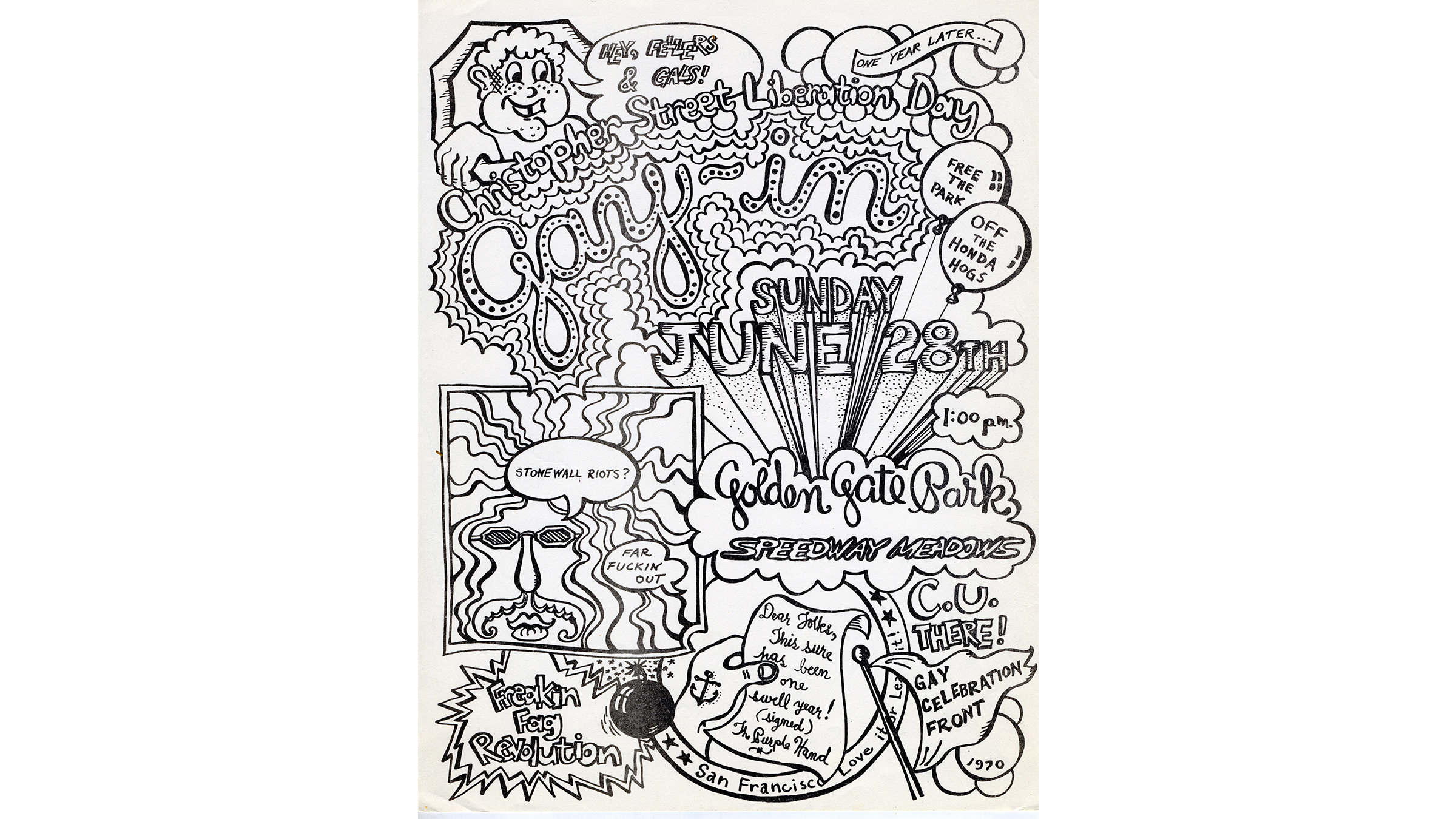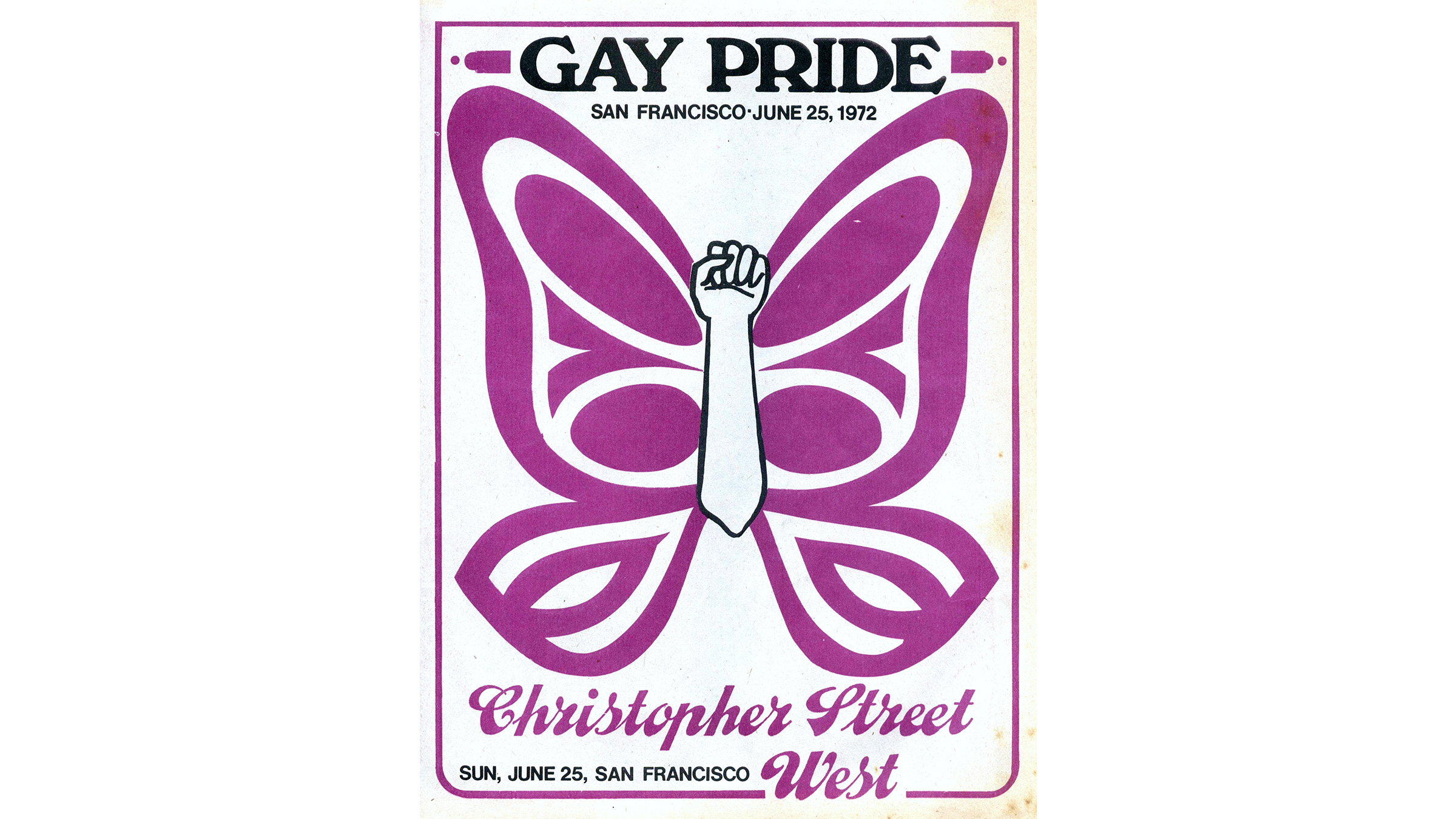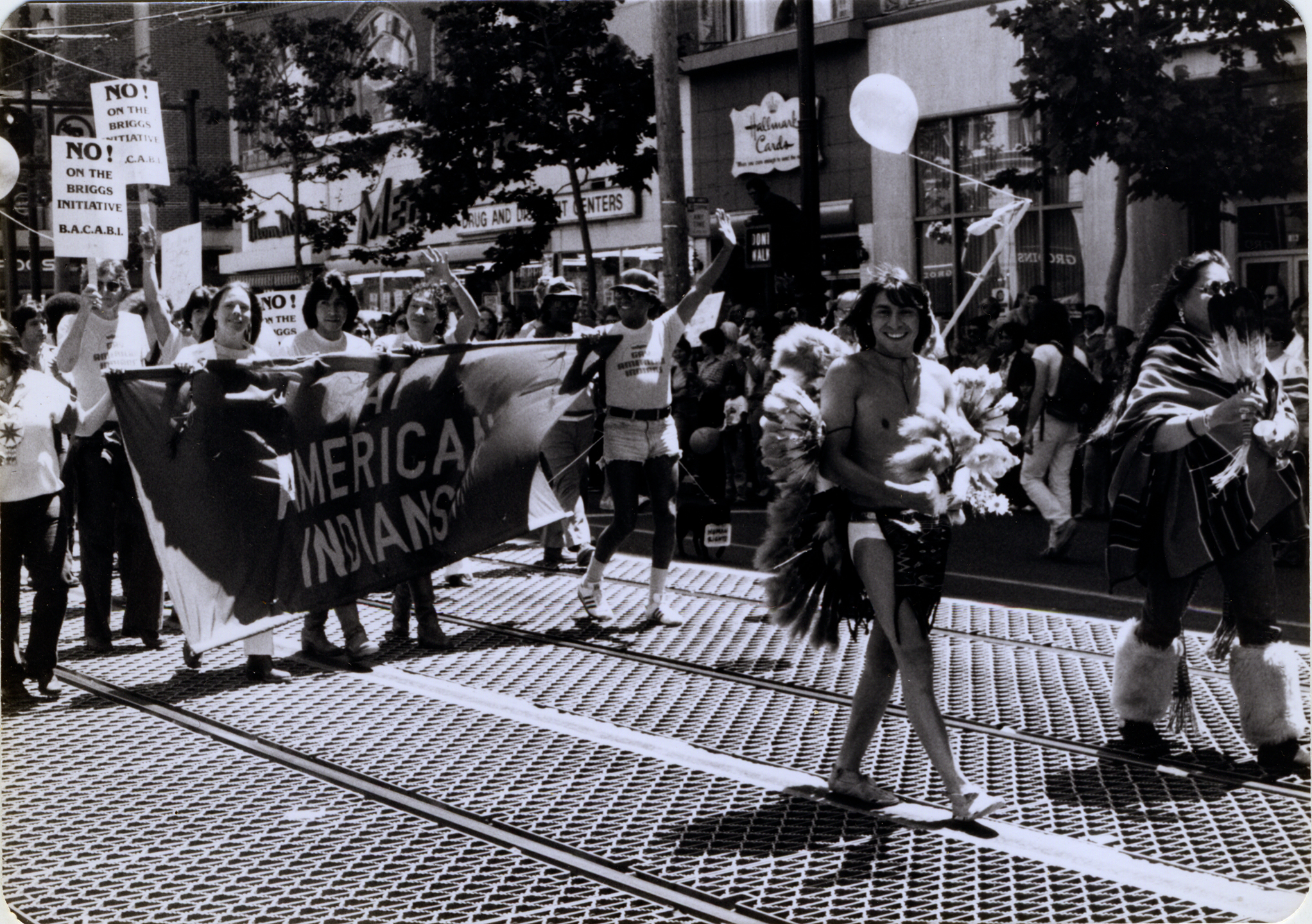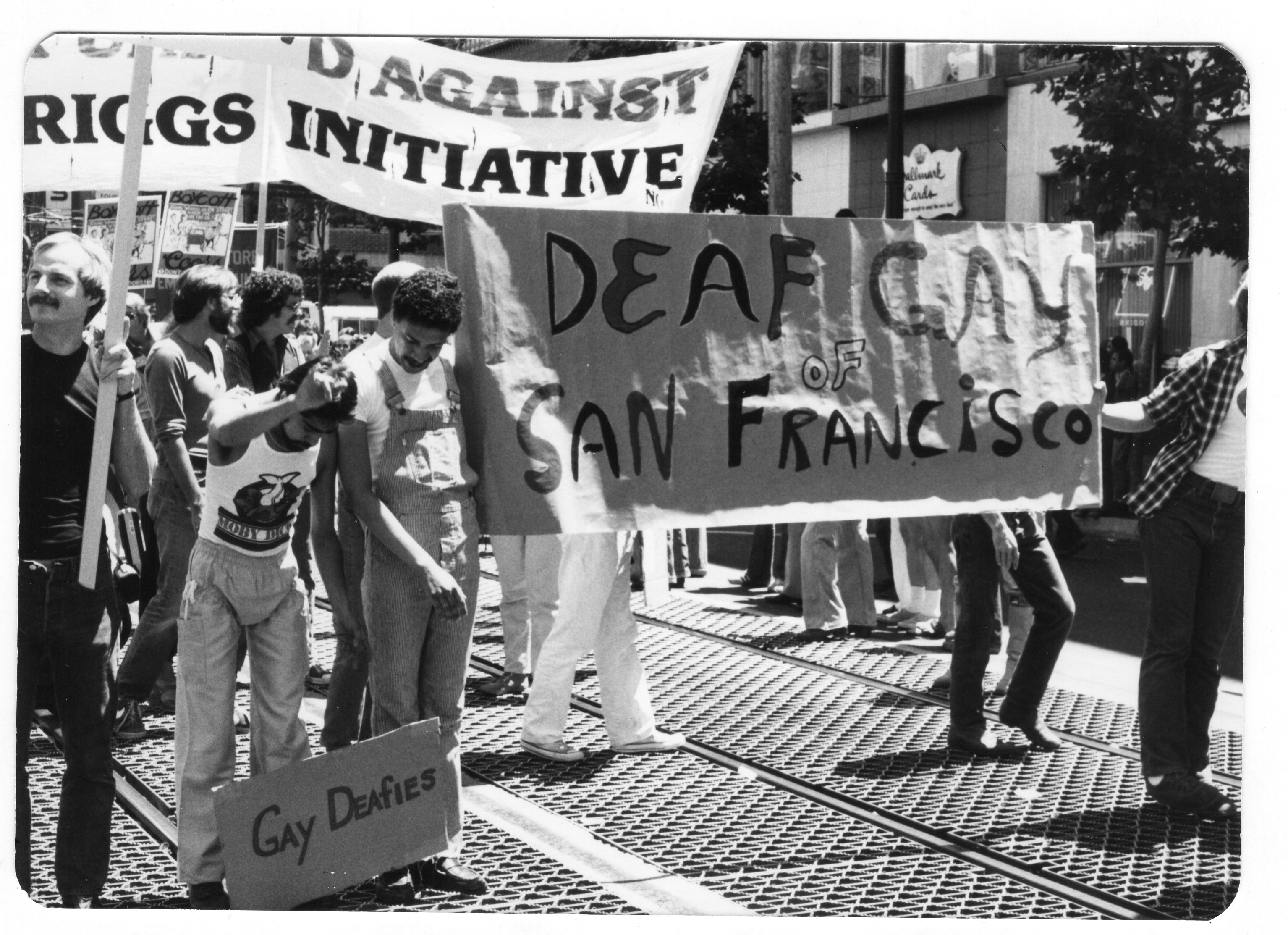Queers Built This is a project about queer inventiveness and DIY culture then, now, and tomorrow.
San Francisco’s first LGBTQ Pride parade was almost unrecognizable by today’s standards. To pay tribute to the first anniversary of the Stonewall riots in New York City—a six-day clash between police and queer bargoers in the West Village—around 30 people gathered on June 27, 1970 for a short march down Polk Street. The marchers were largely hippies, radicals, and “hair fairies,” the latter a colloquial term for trans people before the word “transgender” was popularized. There were no floats and no rainbow Pride flags at the march, as the design for the iconic LGBTQ banner wouldn’t be created by Gilbert Baker until 1978.
A “gay-in” held at Golden Gate Park the next day was similarly low-key, drawing about 200 people. It more closely resembled a large family picnic than the modern equivalent of Pride, a corporate-funded saturnalia featuring mid-level executives dancing on Wells Fargo floats to Lady Gaga. Beyond aesthetics, though, one of the starkest differences between early Pride parades and actions and the ones we have now is the relationship to law enforcement: Today, Pride parades have a heavy police presence, whereas the San Francisco gay-in ended with cops rounding up and arresting attendees.
This “gay in” was five years before California repealed its anti-gay sodomy laws, and homosexuality was still illegal in the vast majority of U.S. states. The frequent police raids at bars like the Black Cat Tavern in Los Angeles in July 1967, in which undercover officers began beating and handcuffing patrons who were kissing to celebrate New Year, were a reminder that the very fact of being gay was treated as a criminal act.

Gerard Koskovich, an independent public historian and founding member of the GLBT Historical Society, said that media coverage of the arrests illustrates how much has changed between 1970 and 2020. One of the organizers of the gay-in told local press that attendees of the event “were engaged in peace and love” and “invited the officers to dismount from their horses” and partake in the festivities. “But instead they just wanted to persecute us. And if this persecution doesn't stop, the only option will be armed revolution,” the participant said.
“How many people think of armed revolution when they think of a Pride parade?” Koskovich asked with a laugh. “It’s important to remember that Pride started as a combination of militancy against extreme oppression and a celebration of desire, love, and pleasure. It’s been a balancing act, and sometimes a battle between political struggle and celebration.”
These early days of San Francisco Pride are soon to be the subject of Labor of Love, a virtual exhibit that Koskovich co-curated for the GLBT Historical Society. The show is set to premiere online June 15 and features photographs, posters, flyers, film, and recorded sound depicting 1970s Pride marches as a space of possibility; it portrays the LGBTQ community as engaged in passionate debate over what an all-encompassing event representing the movement should be, as Pride grew exponentially in both size and spectacle. By 1980, what was once a relatively informal march had become a 250,000-person disco cavalcade down the streets of San Francisco.
Don Romesburg, one of the two other curators of the exhibition, said that even from the beginning, there were debates about what a gathering that brought together such a wide spectrum of identities should look like.
“There's nothing inherent that ties together gay men, lesbians, bisexual people, trans people, drag queens, leather daddies, bears, queer people of color, and queer people with disabilities,” said Romesburg, a professor in women’s and gender studies at Sonoma State University. “For us to all imagine that we are collectively part of the same community and to stand in solidarity with one another requires that we all have a place that we have to gather and be together. Pride becomes that space.”

One indication that, in the early years of San Francisco Pride, the mission was still under contention was that the name itself changed frequently. The festivities went on hiatus in 1971, but by 1972, the gathering was formally known as Christopher Street West. The event underwent a name change yet again the following year, to Gay Freedom Day. It held that title all the way until 1981, when it was renamed the International Lesbian and Gay Freedom Day Parade. Pride wasn’t ever referred to as such until 1995—25 years into the event’s history.
The 1972 Pride was the first that might be described as a parade, with marchers joined by automobiles cruising the streets as onlookers watched from the sidewalks. Koskovich said most of those cars and floats had a “do-it-yourself” look to them. “They were cobbled together out of whatever means people had with very little money,” he said. “Contingents had homemade banners. Floats were put together with cardboard boxes and crepe paper.”
While combing through thousands of photographs to put together the exhibition, Koskovich said he found the look of the early Prides “so charming and welcoming,” exuding an atmosphere in which “anybody” can participate as long as they had “ingenuity and the nerve.” But not everyone saw the parades that way. The events were the subject of heavy debate over who and what the LGBTQ community should include and celebrate in its events. Would butch lesbians and drag queens be allowed to march? Is nudity permitted in the parade? Should gay bars be allowed to participate?
The lion’s share of criticism, according to Koskovich, came from the “existing gay establishment” in San Francisco at the time. The city was home, for instance, to the
Daughters of Bilitis and the Mattachine Society, then the world’s two largest LGBTQ advocacy organizations. These groups, which emerged in the 1950s, had long fought internally over what the goals of LGBTQ organizing should be: Do LGBTQ people assimilate into society or should they insist on liberation?
The more conservative faction of that divide argued that Pride should not include anyone who “doesn’t look like they would fit into a middle-class suburb” because they feared cisgender heterosexuals would deny them equal rights, Koskovich said. One flier included in the exhibition parodied this mindset by declaring the “official pride uniform” to be a “gray business suit.” Other photographs on display depict what was often a fraught, heated battle for the soul of Pride in a comic way. Another of Koskovich’s favorite pieces depicts bare-breasted lesbians proclaiming that their naked bosoms are “one of the great things that they have to bring to the parade.”
Initially, at least, attempts to mainstream emerging Pride events didn’t fit in with the “anti-assimilationist, pro-sex, radical” ethos of an era defined by the Civil Rights Movement and liberationist groups like the Black Panthers, as Koskovich explained. “These were largely organizations that were looking to portray lesbian and gay people as respectable, responsible citizens and as members of society who could fit in if people would just let them,” he said. “By the end of the 1960s, that was not the politics.”

But the conversation surrounding Pride shifted dramatically as the convening began to evolve. The success of the early gatherings led to increased attendance, and soon it became necessary for organizers to raise money for Pride. In a 1975 column for the Bay Area Reporter included in the exhibit, Harvey Milk — who would be elected to the San Francisco Board of Supervisors two years after — called upon the municipal government to provide funding for an event that had already grown into one of the Bay Area’s largest. Unlike every other parade and celebrations that confettied the city’s streets, the city did not offer up any public dollars.
San Francisco would begin funding Pride in 1976, but discussions about where the money for Pride should come from—and whether businesses and major corporations should be involved—became one of the defining features of behind-the-scenes organizing. As more people began attending, it was no longer feasible to have an informal promenade in which anyone standing on the sidelines could hop in the parade if they wished. Pride became more structured, more expensive, and attracted interest from mainstream LGBTQ groups that had once shunned it.
It was around this time that Romesburg said there became “more collaboration with civil authorities in order to coordinate the events,” whether it was San Francisco city officials or eventually the very police forces that had targeted the first Pride event. By the end of the 1970s, sponsorship for the event was not solely relegated to gay bars and nightclubs. Larger businesses, including those not formally aligned with the LGBTQ community, began to buy into Pride.
But Amy Sueyoshi, the exhibition’s third co-curator, said it was not merely the need for funding that transformed Pride into the more sanitized version with which we are now familiar. The general public, by and large, had become more accepting of LGBTQ people. By 1977, public opinion surveys conducted by Gallup showed that 56 percent of Americans felt LGBTQ people should have “equal rights” to job opportunities as heterosexual, cisgender people. Those trends would continue in subsequent decades: A majority of the American public favored the decriminalization of homosexuality by 1992, same-sex adoptions by 2003, and marriage equality by 2012.
“As we become a nation that's increasingly sympathetic toward queers, gays and lesbians are increasingly folded into assimilative politics,” said Sueyoshi, dean of the college of ethnic studies at San Francisco State University. “It’s less about corporations changing Pride and more about how the mainstreaming of queers in America has allowed corporations to come in.”

The curators behind Labor of Love agreed something about Pride has been “lost” as companies like American Airlines, Anheuser-Busch, and Miller signed on as corporate partners in subsequent years, which took place as early as 1996. That year, the San Francisco Examiner described the parade as more like the “Super Bowl” than a homegrown celebration of the LGBTQ community, and those criticisms have not abated since. Last year, protesters who called upon San Francisco Pride to end its relationships with corporations and the police blocked the parade for over an hour. Similar efforts have been mounted in Chicago, New York, Seattle, and Portland, Oregon.
But Sueyoshi, who sits on the board of San Francisco Pride, claimed that the reality is that organizers of contemporary Pride events “wouldn't be able to put on the enormous pride that [they] do without corporate sponsors.”
“If we had a small pride like we used to—a couple of hundred folks marching down the street and then a picnic in Golden Gate Park—we wouldn't need corporate sponsorships,” they said. “I don't know if that day is ever going to come back where queers can have a parade and only a couple of hundred people will show up. That’s both the wonder and the sadness of what it means to become mainstream.”
The curators behind Labor of Love hope the exhibit can help LGBTQ people envision what a truly representative Pride might look like in 2020. They also hope, however, that the materials on display are a reminder that continuing to put on an event that brings together such an expansive community is an enormous amount of work. Sueyoshi said they were “inspired” by the fact that even though documents the team unearthed showed that Pride organizers kept “resigning year after year” in the face of sustained criticism, the parade has kept marching on. Even though the in-person gathering was cancelled in 2020 for the first time in its history due to the COVID-19 pandemic, San Francisco Pride will still be holding a digital version of the event.
“This exhibit allowed me to fall back in love with Pride,” Romesburg said. “I'm about to turn 50, and I've been going to prides since the early 1990s. I'm one of those gays who has felt over Pride for a number of years, but doing this exhibit reminded me of why Pride continues to be so important. It’s a space where we can all come together and reimagine what it might mean to be in community with one another.”
Visit GLBTHistory.org on June 15 to view Labor of Love.
from VICE https://ift.tt/3dFsny6
via cheap web hosting

No comments:
Post a Comment